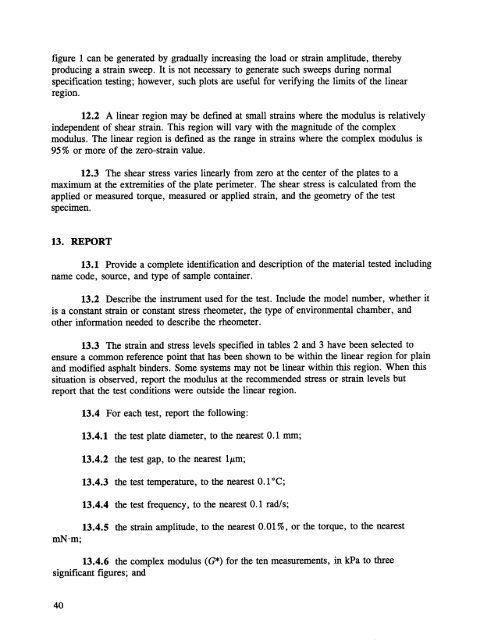Create successful ePaper yourself
Turn your PDF publications into a flip-book with our unique Google optimized e-Paper software.
figure 1 can be generated by gradually increasing the load or strain amplitude, thereby<br />
producing a strain sweep. It is not necessary to generate such sweeps during normal<br />
specification testing; however, such plots are useful for verifying the limits of the linear<br />
region.<br />
12.2 A linear region may be defined at small strains where the modulus is relatively<br />
independent of shear strain. This region will vary with the magnitude of the complex<br />
modulus. The linear region is defined as the range in strains where the complex modulus is<br />
95 % or more of the zero-strain value.<br />
12.3 The shear stress varies linearly from zero at the center of the plates to a<br />
maximum at the extremities of the plate perimeter. The shear stress is calculated from the<br />
applied or measured torque, measured or applied strain, and the geometry of the test<br />
specimen.<br />
13. REPORT<br />
13.1 Provide a complete identification and description of the material tested including<br />
name code, source, and type of sample container.<br />
13.2 Describe the instrument used for the test. Include the model number, whether it<br />
is a constant strain or constant stress rheometer, the type of environmental chamber, and<br />
other information needed to describe the rheometer.<br />
13.3 The strain and stress levels specified in tables 2 and 3 have been selected to<br />
ensure a common reference point that has been shown to be within the linear region for plain<br />
and modified asphalt binders. Some systems may not be linear within this region. When this<br />
situation is observed, report the modulus at the recommended stress or strain levels but<br />
report that the test conditions were outside the linear region.<br />
13.4 For each test, report the following:<br />
13.4.1 the test plate diameter, to the nearest 0.1 mm;<br />
13.4.2 the test gap, to the nearest l#m;<br />
13.4.3 the test temperature, to the nearest 0.1°C;<br />
13.4.4 the test frequency, to the nearest 0.1 rad/s;<br />
mN.m,<br />
13.4.5 the strain amplitude, to the nearest 0.01%, or the torque, to the nearest<br />
13.4.6 the complex modulus (G*) for the ten measurements, in kPa to three<br />
significant figures; and<br />
4O



